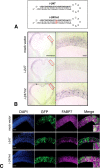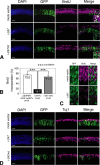Role of Fabp7, a downstream gene of Pax6, in the maintenance of neuroepithelial cells during early embryonic development of the rat cortex
- PMID: 16237179
- PMCID: PMC6725737
- DOI: 10.1523/JNEUROSCI.2512-05.2005
Role of Fabp7, a downstream gene of Pax6, in the maintenance of neuroepithelial cells during early embryonic development of the rat cortex
Abstract
Pax6 is a transcription factor with key functional roles in the developing brain. Pax6 promotes neuronal differentiation via transcriptional regulation of the Neurogenin2 (Ngn2) gene, although Pax6 expression appears in proliferating neuroepithelial cells before the onset of neurogenesis. Here, we identified Fabp7 (BLBP/B-FABP), a member of the fatty acid-binding protein (FABP) family, as a downregulated gene in the embryonic brain of Pax6 mutant rat (rSey2/rSey2) by microarray analysis. Marked reduction of Fabp7 expression was confirmed by quantitative PCR. Spatiotemporal expression patterns of Fabp7 in the wild-type rat embryos from embryonic day 10.5 (E10.5) to E14.5 were similar to those of Pax6, and expression of Fabp7 was undetectable in the rSey2/rSey2 cortex. The expression pattern of Fabp7 in the wild-type mouse embryo at E10.5 (corresponding to E12.5 rat) was different from that in the rat embryo, and no change of expression was observed in the Sey/Sey mouse embryo. Overexpression of exogenous Pax6 mainly induced ectopic expression of Fabp7, rather than of Ngn2, in the early cortical primordium. Interestingly, knocking-down FABP7 function by electroporation of Fabp7 small interfering RNA severely curtailed cell proliferation but promoted neuronal differentiation. We conclude that Fabp7 is a downstream gene of Pax6 transcription factor in the developing rat cortex and essential for maintenance of neuroepithelial cells during early cortical development.
Figures





References
-
- Anthony TE, Klein C, Fishell G, Heintz N (2004) Radial glia serve as neuronal progenitors in all regions of the central nervous system. Neuron 41: 881-890. - PubMed
-
- Brummelkamp TR, Bernards R, Agami R (2002) A system for stable expression of short interfering RNAs in mammalian cells. Science 296: 550-553. - PubMed
Publication types
MeSH terms
Substances
LinkOut - more resources
Full Text Sources
Other Literature Sources
Molecular Biology Databases
